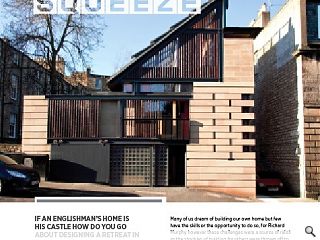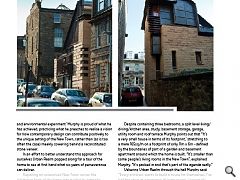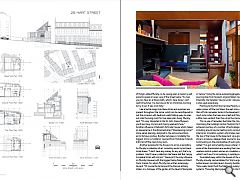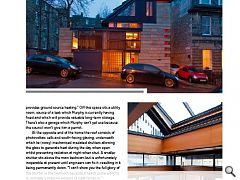Murphy House: Tight Squeeze
15 Apr 2015
If an Englishman’s home is his castle how do you go about designing a retreat in a city defined by an existing fortification? For Richard Murphy the answer is a stone clad town house that exalts in ripping up the new town rulebook. Photography by Stephen Leonard
Many of us dream of building our own home but few have the skills or the opportunity to do so, for Richard Murphy however these challenges were a source of relish as the shackles of building for others were thrown off to finally do something for himself. If the goal was one of rest and comfort though the journey was anything but as the architect launched head first into the delivery of an uncompromisingly modern property within one of the most restrictive planning environments in the world, Edinburgh’s New Town World Heritage Site.Driving a wedge through planning (and some locls) the sloping home has endured a tortuous ride through planning but has delivered one of the city’s most adaptable and sustainable homes.
Describing the house as ‘something of an architectural and environmental experiment’ Murphy is proud of what he has achieved, practicing what he preaches to realise a vision for how contemporary design can contribute positively to the unique setting of the New Town, rather than (as is too often the case) meekly cowering behind a reconstituted stone veneer.
In an effort to better understand this approach for ourselves Urban Realm popped along for a tour of the home to see at first hand what six years of perseverance can deliver.
Repairing an unresolved New Town corner the distinctive form of the home was guided by tight site constraints, leading to a ‘bookend’ design to mask an exposed gable which was never intended to be on view. Within these limitations Murphy has been careful to preserve the privacy and views of his neighbours, delivering its distinctive sloping roof.
Having just moved into his new pad over Christmas Murphy is still dealing with a procession of tradesmen applying those vital finishing touches, not least sourcing a window cleaner willing and able to take on the idiosyncratic geometry of skylights and customised glazing. More frivolous items such as artwork and a set-piece grandfather clock await the day when budget allows.
Despite containing three bedrooms, a split level living/dining/kitchen area, study, basement storage, garage, utility room and roof terrace Murphy points out that “It’s a very small house in terms of its footprint,’ stretching to a mere 165sq/m on a footprint of only 11m x 6m –defined by the boundaries of part of a garden and basement apartment around which the home is built. “It’s smaller than some people’s living rooms in the New Town”, explained Murphy. “It’s packed in and that’s part of the agenda really.”
Ushering Urban Realm through the hall Murphy said: “Every architect wants to build a house for themselves; I’ve had the unusual experience of living in two. I previously lived In Regent Terrace Mews which I designed for a client and then bought off her and sold it back to her.”
Internally the home is dominated by a large open-plan living room/diner resting on a giant Tata steel girder. At the heart of things is a log burning stove from which heat can be extracted for hot water, an important resource for one of the main bedrooms in particular.
Climbing a narrow staircase Murphy motioned past some dry cleaning toward a wooden cabinet beside his bed, remarking: “This is the bath,” before proceeding to slide and swivel the top and sides, latching them into place to reveal the hollow chamber within. “This is the more eccentric side of things’, added Murphy, as he swung open a masonry wall panel to reveal an open view of the street below. “So now you can have an al fresco bath, which I have done, I can’t wait till Summer. I’ve had one so far on Christmas morning to try it out. It was a bit chilly.”
Like a tactile magic box these tricks and surprises are present throughout the home, which can be reconfigured to suit the occasion with bedroom walls folding away to open out onto the living room for true open plan living. Murphy said: “I’m very interested in the Sir John Soane Museum, you’ll see many mirrors and moving elements here.” Another influence is Reitveld’s Schroder house which makes an appearance in the aforementioned “disappearing corner” stone panel opening, designed to the same proportions as his famous window. Another set-piece is ‘probably the biggest mirror in Scotland,’ sourced from Yorkshire it stands 4.6m tall off the main living room.
Another purpose for the house is to act as a repository for Murphy’s collection of art, including works by his friend Linda Green. “I don’t have any money for any art, that’s my problem. I don’t have a collection like Soane did. But I enjoy his spatial tricks with mirrors.” Soane isn’t the only influence on Murphy however with the biggest being Italian architect Carlo Scarpa, for whom Murphy has written extensively. He said: “Of course the terrace and the tiles are entirely stolen, or a homage, of the garden at the Querini Stampalia in Venice.” Using the same exposed aggregate finish and sourcing tiles from Scarpa’s original Italian manufacturer. Internally, the Venetian ‘stucco lucido’ coloured plasterwork is also used extensively.
Pointing to the first floor terrace Murphy said: “The water comes off the roof down the wall, into a pond and then off into rainwater tanks in the basement. It will be much nicer when the trees are in leaf and things are looking a little more verdant than they do at the moment.”
This re-use of rainwater illustrates the importance of minimising the building’s carbon footprint to the design, achieved courtesy of a number of technological tricks, including ground source heating and a computerised internal air circulation system which takes warm air from the top of the house to the basement via a gravel rock store to produce a delayed heat source for evening use. Commenting on the practicalities of such systems Murphy added: “I’ve got some heating issues where I don’t think some of the thermostats are sending their messages to the wireless control system and an air circulation system which, whilst I can’t say it’s not working, is puzzling me.”
Squirrelled away within the bowels of the property Murphy proudly, demonstrated his ‘ship’s engine room’, a subterranean concrete cavern housing building services. “Grey water tanks flush the toilets and supply the sprinkler systems. Those big black pipes go 150m into the ground to provides ground source heating.” Off this space sits a utility room, source of a leak which Murphy is currently having fixed and which will provide valuable long-term storage. There’s also a garage which Murphy can’t yet use because the council won’t give him a permit.
At the opposite end of the home the roof consists of photovoltaic cells and south-facing glazing, underneath which lie (noisy) mechanised insulated shutters allowing the glass to generate heat during the day when open whilst preventing radiation at night when shut. A smaller shutter sits above the main bedroom but is unfortunately inoperable at present until engineers can fix it, resulting in it being permanently down. “I can’t show you the full glory of the shutter in the bedroom because it needs some work to it, normally a massive amount of light comes in.”
With the finishing touches still being applied Murphy’s home can only improve with the passage of time, bedding down into its environment as gracefully as its surroundings have done. It also points the way ahead for utilising left over urban gap sites for new housing, a skill Edinburgh would do well to learn from.
Murphy is holding off on hosting a housewarming until his 60th birthday in April, relishing an opportunity to win over neighbours and demonstrate that the most impressive aspect of Murphy’s House is not its architectural vision but that it is still a home for all that.
|
|
Read next: Discovering Designers: Iwa Herdensjӧ
Read previous: Tower Blocks
Back to April 2015
Browse Features Archive
Search
News
For more news from the industry visit our News section.
Features & Reports
For more information from the industry visit our Features & Reports section.






